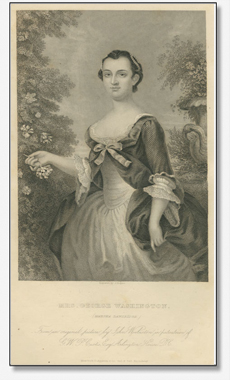
Rufus W. Griswold, The Republican Court, or, American Society in the Days of Washington. New and rev. ed. (New York, 1856), frontispiece. First ed., 1855.
MARTHA DANDRIDGE CUSTIS WASHINGTON (1731-1802) Born on a plantation near Williamsburg, Virginia, Martha was the eldest child of John and Frances Jones Dandridge. Despite her family’s modest means, she grew up among the wealthy plantation families in eastern Tidewater Virginia, and so was no stranger to the strictures of high society.[1] In accordance with the customs of the day, she had little formal education, instead receiving a “lady’s education,” which emphasized “music, the arts, dress, fine sewing, dancing, demeanor, [and] household management.”[2] Martha would always prefer the familiarity and peace of domestic life over the demands of high society. In 1750 Martha married Daniel Parke Custis, a wealthy planter twenty years her senior.[3] They had four children, two of whom died in infancy; in 1757 Custis also died, leaving Martha not only with two small children but also as one of the wealthiest women in Virginia.[4] Two years later she married George Washington (1732-1799), and moved with her children to Mount Vernon, his northern Virginia plantation.[5] Martha thrived in the social life at Mount Vernon, and her warm and welcoming demeanor soon provided the basis for its renowned hospitality.[6] The peace of her home, however, was inalterably changed when Washington’s position as commander-in-chief of the Continental Army kept him away from home for months at a time. During the winter of 1775 Martha began a tradition of visiting him at his winter camps during the war, where her “her cheerful presence and the steadying sight of her constant sewing did much to encourage both the Commander and the troops.”[7] In 1781, Martha Washington’s only surviving child, John Custis, died, and his two youngest children, Eleanor (“Nelly”) and George (“Washy”), became permanent residents at Mount Vernon.[8] In 1789 when Washington was elected first president of the United States, the family moved with him to New York, and then Philadelphia. Martha was not “best pleased by the honor,” having hoped instead for a peaceful life of retirement with her husband,[9] but she bowed “without relish to the social demands now placed upon her by the Federalist concept of the presidency as a highly dignified, almost regal office.”[10] As the new nation’s first First Lady, Martha was to set the standard for the entertainment style of the presidency for those who would follow her.[11] The Washingtons sought to establish the American presidency as the equal to that in any European capital,[12] and accordingly, each week Washington formally received foreign ambassadors and other gentlemen who wished to be introduced to him.[13] In addition, the couple presided over official state dinners on Thursday nights, drawing from guest lists that were usually balanced geographically and politically to avoid any overtones of favoritism.[14] Finally, “Lady Washington,” as she was sometimes called, hosted Friday evening receptions known as “levees,” where formal attire was required, but which nonetheless had an atmosphere “of a pleasant informality.”[15] Daniel Huntington’s 1861 history painting Lady Washington’s Reception Day depicted such a levee, with Martha portrayed as a queen. Critics at the time objected,[16] but this courtly image, which also circulated widely as a popular print, still appears in texts to illustrate the elite culture during the Washington presidency. In 1797, to Martha’s delight, the Washingtons returned to Mount Vernon for their retirement. Two years later, Washington died, and three years after, in 1802, Martha died before her seventy-first birthday. She lies buried at Mount Vernon beside her husband.[17] Written by Janet Hallahan. Additional portraits appear in:
______________________ [1] Notable American Women 1607-1950, s.v. “Washington, Martha Dandridge Custis.” [2] Patricia Brady, “Martha Dandridge Custis Washington,” in American First Ladies: Their Lives and Their Legacy, ed. Lewis L. Gould (New York: Garland Publishing, 1996), 3. [3] Ibid., 4. [4] American National Biography, s.v. “Washington, Martha Dandridge Custis.” [5] Ibid.; Notable American Women, “Washington.” [6] Ibid. [7] Ibid. [8] Brady, American First Ladies, 7. [9] Ibid., 8. [10] Notable American Women, “Washington.” [11] Brady, American First Ladies, 3. [12] American National Biography, “Washington.” [13] “Mrs. Martha Washington,” in The National Portrait Gallery of Distinguished Americans (Philadelphia: Henry Perkins, 1836), “Martha Washington.” [14] Patricia Brady, Martha Washington: An American Life (New York: Penguin Books 2006), 165; Brady, American First Ladies, 8. [15] Brady, Martha Washington, 165; Notable American Women, “Washington.” [16] Eliza Tamarkin, Anglophilia: Deference, Devotion, and Antebellum America (Chicago: University of Chicago Press, 2008), 56. [17] Notable American Women, “Washington.” |

